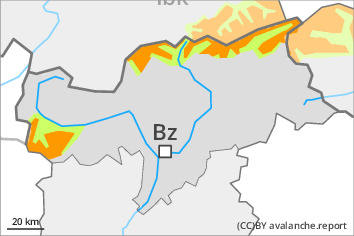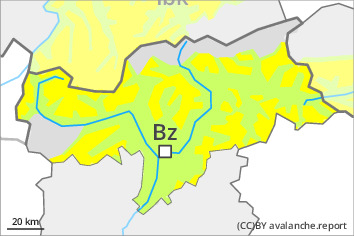
Danger level
 | 2000m |
|  |
|  | ||||
|  |
|  |

Weakly bonded old snow above approximately 2000 m. Fresh wind slabs require caution.
Single winter sport participants can release avalanches. These can penetrate even deep layers and reach large size in isolated cases. This applies in particular on very steep shady slopes in high Alpine regions. The avalanche prone locations are to be found in all aspects above approximately 2000 m. Between approximately 2000 and 2400 m the avalanche prone locations are more prevalent. These places are difficult to recognise. Whumpfing sounds and the formation of shooting cracks when stepping on the snowpack can indicate the danger. Caution is to be exercised at transitions from a shallow to a deep snowpack.
As a consequence of the sometimes storm force wind the wind slabs will increase in size once again. The avalanche prone locations are to be found in particular adjacent to ridgelines and in gullies and bowls and on steep shady slopes.
Experience in the assessment of avalanche danger is required.
Snowpack
dp.1: deep persistent weak layer
dp.6: cold, loose snow and wind
Some snow has fallen. Over a wide area strong northwesterly wind. The strong wind will transport the new snow and, in some cases, old snow as well. The snowpack will be subject to considerable local variations.
Faceted weak layers exist in the bottom section of the snowpack at elevated altitudes. Faceted weak layers exist in the top section of the snowpack in all aspects. This applies especially between approximately 2000 and 2400 m.
Fresh wind slabs are lying on soft layers in particular on shady slopes at elevated altitudes.
Tendency
Wind slabs and weakly bonded old snow require caution. On Sunday as a consequence of new snow and wind there will be an increase in the avalanche danger within the current danger level.



